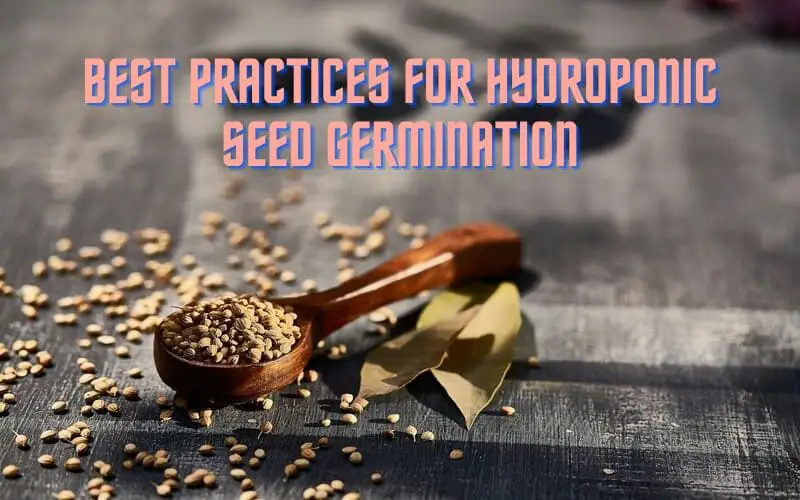Best Practices for Hydroponic Seed Germination: Four Factors

Introduction
Welcome to the world of hydroponic seed germination! Whether you’re a seasoned grower or just starting out, mastering the best practices for hydroponic seed germination is crucial for achieving robust and healthy plant growth. In this article, we’ll explore the top 4 best practices for hydroponic seed germination, uncovering valuable insights and expert tips to help you optimize your growing system effectively.
Optimal Temperature and Humidity
When it comes to hydroponic seed germination, achieving and maintaining optimal temperature and humidity levels is crucial for ensuring the successful development of seedlings. Seeds require specific conditions to sprout and grow into healthy plants, and controlling the temperature and humidity of your growing environment is a fundamental practice to support this process.
Let’s delve deeper into the importance of temperature and humidity regulation in hydroponic seed germination:
- Temperature Regulation
- Seeds have a preferred temperature range for germination, and maintaining this range is essential for successful seed sprouting. Different plant species may have varying temperature requirements, so it’s important to research the optimal germination temperature for the specific seeds you are working with.
- High temperatures can lead to heat stress and inhibit germination, while low temperatures can slow down the process or even cause the seeds to rot. It is crucial to provide a stable and favorable temperature environment to promote healthy seedling development.
- By using tools like thermostats and heaters, growers can create and maintain the ideal temperature conditions for hydroponic seed germination. It’s important to monitor and adjust the temperature as needed to support the different stages of seedling growth.
- Humidity Regulation
- Humidity levels play a critical role in seed germination and early seedling growth. Seeds absorb moisture from their surroundings, and the level of humidity directly affects this process. Too little humidity can lead to desiccation and hinder germination, while too much moisture can promote fungal growth and lead to damping off.
- Utilizing tools like humidity domes and humidity meters, growers can closely monitor and adjust the humidity levels in their hydroponic systems. By providing the ideal level of moisture in the air, growers can facilitate the germination process and support the healthy development of seedlings.
By focusing on precise temperature and humidity control, hydroponic growers can create an environment that optimizes seed germination and fosters the growth of strong, healthy plants.
Proper Lighting Conditions
Importance of Lighting
Optimizing lighting conditions is a critical aspect of hydroponic seed germination. Adequate light exposure is essential for stimulating seedling growth and establishing strong root systems. Providing the right amount of light for your seedlings promotes photosynthesis and overall plant vitality, contributing to successful germination and early growth stages.
- Understanding the Light Spectrum: Different stages of seed germination and plant growth require specific light wavelengths. For example, blue light is essential for seedling growth, while red light promotes flowering and fruiting.
- Light Intensity: It’s important to measure and adjust the light intensity based on the growth stage of the plants. Seedlings benefit from lower light intensity to avoid stress, while mature plants thrive under higher light levels.
- Duration of Light Exposure: Controlling the duration of light exposure is crucial. Young seedlings may require shorter photoperiods, while mature plants often need longer periods of light exposure for healthy growth.
Nutrient Solution Management
Know Your Nutrients
Managing the nutrient solution in your hydroponic system is a key best practice for seed germination. The balance and composition of nutrients directly impact seedling development and early plant growth. Ensuring that the nutrient solution is properly formulated and maintained supports healthy root development and provides essential elements for robust seedling establishment.
- Monitor and adjust the pH levels of the nutrient solution to optimize nutrient availability for seedlings.
- Regularly check the electrical conductivity (EC) to maintain the correct concentration of nutrients in the solution.
- Observe and address any signs of nutrient deficiencies or excesses to prevent stunted growth or damage to seedlings.
Adequate Air Circulation
Importance of Good Air Flow
Achieving adequate air circulation within your hydroponic growing environment is crucial for successful seed germination. Oxygen is vital for root development and overall plant health. Proper air circulation can then facilitate the exchange of gases, preventing issues such as root suffocation and excessive humidity. By ensuring adequate airflow, you create an optimal environment for seedling growth and vitality.
Conclusion
Congratulations! You’ve gained valuable insights into the best practices for hydroponic seed germination. That will empower you to enhance your growing system and achieve exceptional results. Prioritizing optimal temperature and humidity, proper lighting conditions, nutrient solution management, and adequate air circulation will help you.
Isn’t it exciting to embark on the journey of hydroponic seed germination armed with expert knowledge and practical tips? Get ready to witness the remarkable growth and vitality of your plants as you apply these best practices with confidence!
